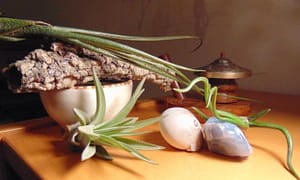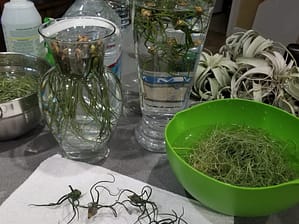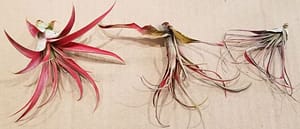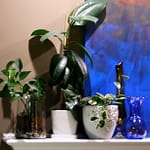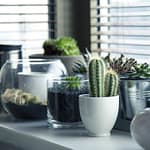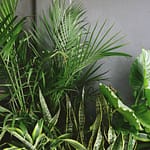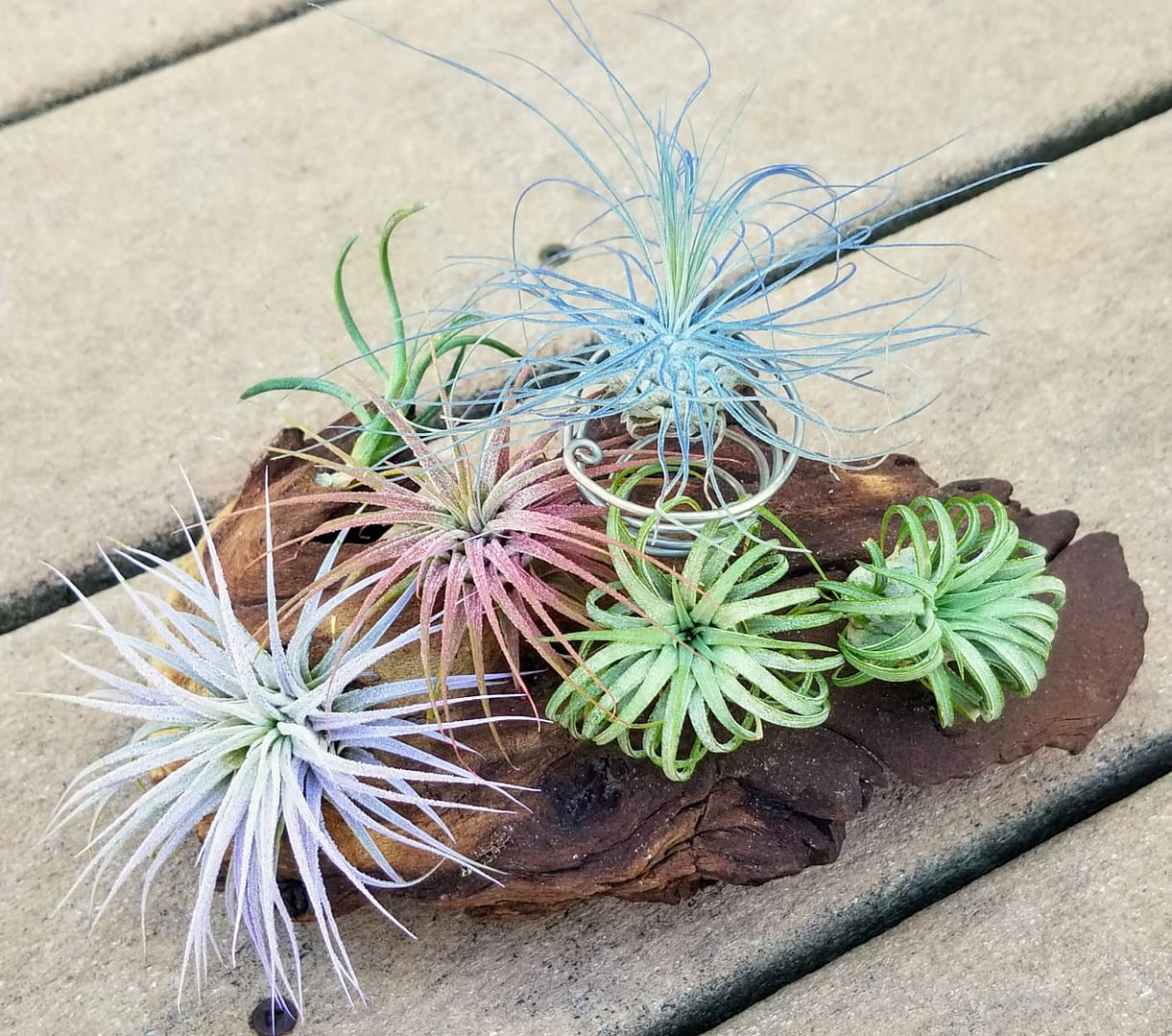
Tillandsias, also called air plants, are easy to grow and low maintenance. But to be successful, there are some characteristics you need to know.
Characteristics
Tillandsia is commonly called “air plant” because it grows without rooting in soil. In nature, air plant species are found in both tropical and semi-tropical regions of United States, Mexico, Central and South America, and the Caribbean. However, many air plant species are also found in semi-arid regions.
Air plants are epiphytes (growing on other plant structures). These plants absorb nutrients from rain water and air moisture through its leaves. The roots are only for mounting on plant structures.
Air plants are also lithophytes, which means that they mount and grow on rock structures.
Growing Tillandsias
Growing air plants is simple and straight forward. But to have success with this, you should follow the general care instructions.
Light
Air plants need bright, indirect light. Place them in a room that gets the brightest light most of the day. If you don’t have a bright room, you can use a broad spectrum grow light in your living space.
Keep air plants away from direct sunlight as much as possible. For most species, the intense light will dry out and burn the leaves of the air plant.
Temperature
The ideal temperature range for air plants is 50 to 90 degrees Fahrenheit. They can tolerate approximately 10 degree lower or higher temperatures but not for prolong periods. Growing them in your home, air plants are happy at a comfortable room temperature setting (warm enough for wear a short-sleeve shirt).
If you live in colder climates during Fall and Winter, be sure to keep air plants away from direct heat sources. Dry heat will certainly dry out your air plant.
Humidity
Humidity levels should be 50% to 70%. Depending on where you live, this can be a challenge. If you grow tropical air plants in an arid climate and/or experience dry Fall and Winter seasons, you can:
- use a cool-mist humidifier
- hand mist the air plant each day or when needed
- display air plant in an open terrarium to contain some moisture
- give air plant a deeper watering (shower or soak) once per week
Desert air plants can will do better under drier conditions. A light mist each day may be enough with a deeper watering at least twice per week.
Air Circulation
As tillandsia air plants need humidity, they also need good air circulation to prevent rot and disease. Always give your air plant good air flow. This is especially important after giving your air plant a deep watering.
Water
Watering your tillandsia air plant with rain water is optimal but may not be practical. If you can collect rain water, great and your air plant will love you for it. If not, they will love you anyway. If you can use tap water, but allow it to sit overnight before use to give time for chlorine and other stuff in the tap water to dissipate.
These are a few watering methods that works well for your air plants once per week:
- heavy mist
- shower
- dunk
Determine which watering method is suitable.
Use a heavy mist or shower method if:
- mounted on a display
- plant is in bloom
- living in a humid climate
You will need to heavily mist or shower the air plant to the point of “run off”. Shake off the excess water. Allow the plant to dry upside down to make sure no pockets of water are still collected in the leaf crevice and plant base. Too much water absorption causes rot. Allow air plant to completely dry with good air flow (avoid using heated air).
Use the bath soak method if:
- starting to look severely dry
- not in bloom
- *growing a tropical species in a drier or arid climate
Fill sink, bowl, or tub with room temperature water. Let air plants soak for 10 to 15 minutes. You can soak longer if necessary (20 to 30 minutes). Gently shake off the excess water. Make sure no pockets of water are still collecting in the leaf crevices to prevent rot. Allow air plant to completely dry with good air flow (avoid using heated air).
*Lightly mist your air plant between waterings each day or as needed. For your tropical air plants, you may need more waterings if there is very little humidity in your home.
Fertilizer
If you collect and use rain water for your tillandsia air plant, you won’t not need to add any fertilizer. The nutrients air plants need is derived naturally from rain water. If you need to use filtered or tap water, you can add a small amount fertilizer made especially for bromeliads and air plants. As air plants are in the Bromeliad family, they require the same nutrient. Avoid other types of fertilizers as they are harmful to air plants.
Generally, fertilize during the growing seasons (Spring and Summer). When plants start going dormant, it is best to halt or significantly reduce fertilizing your air plants.
Signs of Over-watering
Tillandsia air plant need moisture and routine watering, but too much will quickly cause rot. Signs to know if your air plant is getting too much water are starting to rot:
- base of plant feels very soft and no longer firm
- plant base starting to darken or look black
- center leaves easily detach with a gentle tug or top part of plant detaches from the base completely
To prevent this, deeply water no more than once per week according to your climate and air plant species. After watering, shake off excess water and allow to completely dry face down. Provide good air circulation. Air circulation is critical for air plants to dry properly and not hold on to excess moisture. Only soak if air plant starts showing signs of dehydration.
Signs of Under-watering
As mentioned previously, tillandsia air plants need moisture and regular watering. Not enough moisture and water will quickly cause the plant to dry out. Signs to know if your air plant isn’t getting enough water:
- dry brown leaf tips
- leaf curling inward, wilting, and feeling crispy
- base of plant starting to feel dry and hollow
- base no longer firm and plump
Keep a watering and misting schedule. Water (heavy mist, shower, or dunk) at least once per week for tropical species. Lightly mist between waterings (according to your climate). Keep all air plants away from heating elements and direct sunlight to help retain its moisture.
Now that you have a better understanding about the characteristics and care needs of air plants, you should be on your way to successfully growing them.

